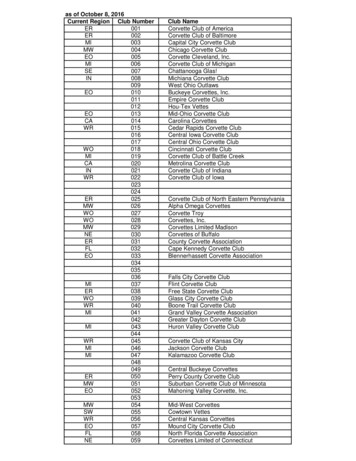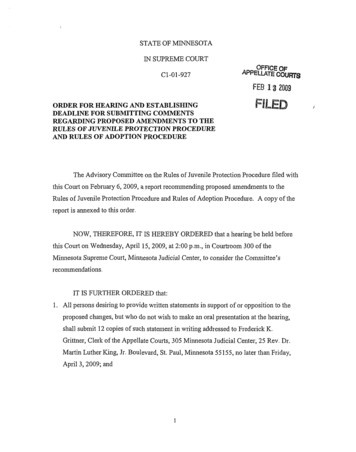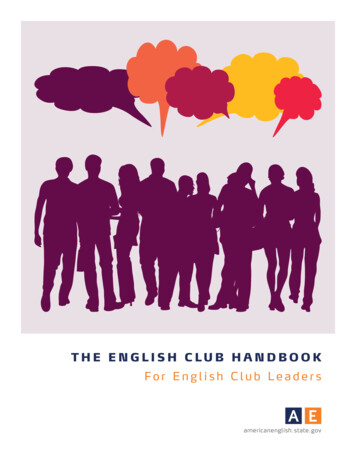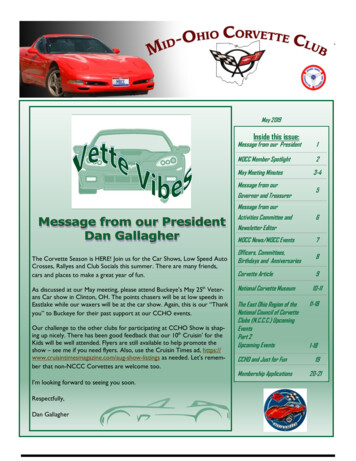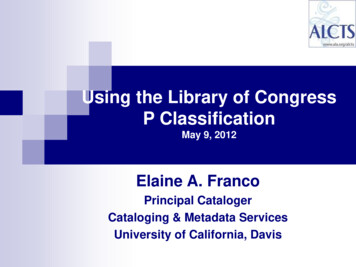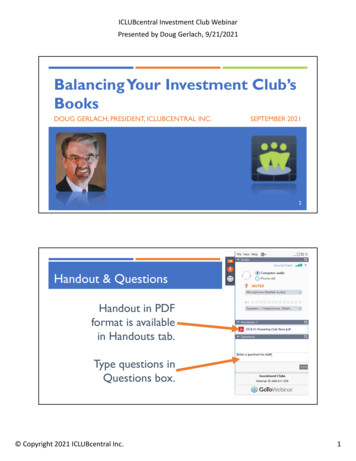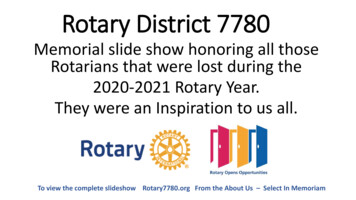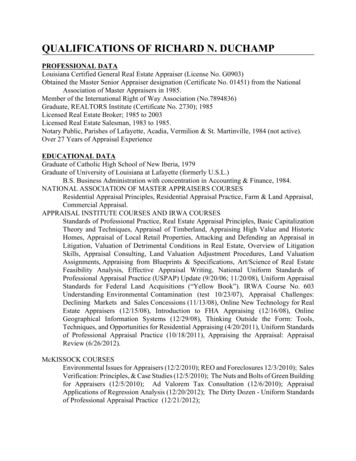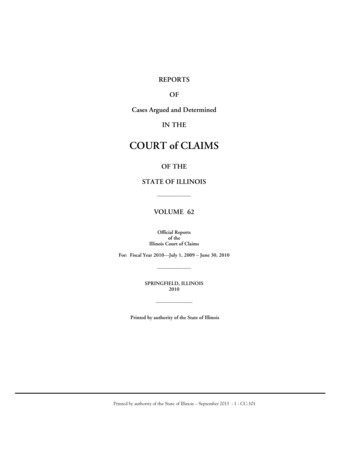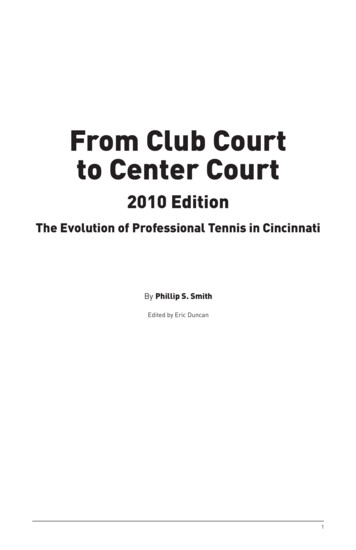
Transcription
From Club Courtto Center Court2010 EditionThe Evolution of Professional Tennis in CincinnatiBy Phillip S. SmithEdited by Eric Duncan1
Cover design by David Mill of Design Mill.Copyright 2010. All rights reserved. No portion of this book may be reproduced withoutwritten permission.Printed in the United States of AmericaISBN 0-9712445-8-82
A Tennis traditionBefore there was a Rose Bowl before the establishment of the Davis Cup, beforebaseball’s first World Series, the first Indy 500, and decades before golf’s Masters, thebest players in tennis were congregating in the southwest corner of Ohio for a veryspecial tournament.That tournament, at first called the Cincinnati Open, is alive and well to this day,crowning champions and entertaining fans. Its 111-year run in the Queen City makesit arguably the oldest tournament in the United States still played in its original city.However, as the word “arguably” in the preceding sentence suggests, this distinction needsa bit of explanation.Two other American tournaments are, in fact, older than Cincinnati – the U.S.National Championships, now known as the U.S. Open, and the Pacific CoastChampionships, now known as San Jose’s SAP Open. The distinction unique toCincinnati, however, is that its tournament is still played in its original city.The U.S. National Championships were first played at the venerable Newport Casinoin Newport, Rhode Island, in 1881. Ironically, the Casino sat approximately 20 milesfrom Narragansett Pier, Rhode Island, where in 1874 vacationing Cincinnatians sawtennis played for the first time. One of those Cincinnatians, Stewart Shillito, was creditedwith bringing the sport back to Cincinnati. In 1878, he built a tennis court – the first onein Cincinnati – at his father’s home in the suburb of Mt. Auburn. Interest in the sportgrew rapidly in the city, and in 1880 a group of players established the Cincinnati TennisClub, which is today one of the oldest active clubs in the nation.The U.S. Nationals continued its run at Newport until 1915, when it moved 175miles southwest to Forest Hills, New York, to find a home at the West Side Tennis Club.Back in Newport, the intrepid tennis enthusiasts wasted no time in replacing the U.S.Nationals with another tournament for their hometown. Only two weeks before theinaugural U.S. Nationals at Forest Hills, the “First Annual Newport Invitational” washeld at the Newport Casino. It featured a 50-man draw in singles, and was won byRichard Norris Williams II, who beat Maurice McLaughlin in four sets in the final. Therewas no women’s competition. Today that event is known as the Campbell’s Hall of FameTennis Championships.The story of the SAP Open’s geographical moves is only slightly more complex. Itbegan in 1889 as the Pacific Coast Championships, and was played at the Del MonteLodge in Monterey. After staying there for an undisclosed period of time, it moved 140miles to the north to the Hotel Rafael in San Rafael, California.It stayed in San Rafael until 1917, and from 1918 to 1971 it was played at either theBerkeley Tennis Club or the California Tennis Club in San Francisco. Today, it is played inSan Jose, 65 miles south of San Rafael and 75 miles north of Monterey.In contrast, the Cincinnati Open was played at the Avondale Athletic Club from 1899to 1902, and then moved two miles away – to the Cincinnati Tennis Club at the corner ofDexter and Wold Avenues in the suburb of East Walnut Hills. With a few exceptions, thetournament was played at that location for the next six decades. Today, it is played in theCincinnati suburb of Mason, about 20 miles from the spot where the tournament’s firstball was struck in 1899.What does all this mean? Maybe it means Cincinnatians are adept at identifyinga good thing and holding on to it. Maybe it means Cincinnatians are so adverse tochange they’ve kept the tournament going over the years simply in order to avoid doingsomething else.Whatever the reason, the simple fact is that the best players in tennis are still findingtheir way to Cincinnati more than 100 years after their first arrival. The names havechanged. The game has changed. But one thing remains: they still come to Cincinnati.If nothing else, that makes Cincinnati a true tennis town, with a tournament historyunlike any other city in America.3
Table of ContentsHISTORYThe Tournament, Year-By-Year – 1899-2008.5-41Index of History Narrative.42-45Tournament Names, Purses, Dates and Venues – 1899-2009. 46-47Firsts & Lasts in Cincinnati.48-49Weather "Highlights" & Surfaces. 49Total Prize Money and Champion's Checks – 1969-2009. 49Men's Trophies Since 1899.50-51Tournament Directors. 52WINNERSWinners & Finalists – 1899-2008.53-64Other Important Area Tournaments. 65Index of All Winners & Finalists – 1899-2008.66-70STATSMen's Singles – Finals Stats.71-81Men's Singles – Semifinals Stats.82-83Men's Singles – Quarterfinals Stats.84-88Men's Singles – Round of 16 Stats.88-89Men's Singles – 1st & 2nd Round Stats.90-91Men's Singles – Qualifier / Lucky Loser Stats. 92Men's Singles – Seeding Stats.93-94Men's Singles – Miscellaneous Stats.95-96Men's Singles – Wild Cards.97-99Women's Singles – Finals Stats.100-102Women’s Singles – Miscellaneous Stats. 102Women's Singles – SF, QF & Seeding Stats. 103Men's Doubles – Open Era Stats.104-105Hall of Famers Who've Played Cincinnati.106-107U.S. Davis Cuppers Who've Played Cincinnati. 107Intercollegiate Champions Who've Played Cincinnati.108-109Singles Champs: Highest Year-End U.S. Rankings. 110RECORDSMen's Singles - Players & Records (Open Era).111-125Men's Doubles - Players & Records (Open Era) . 126-139Women's Singles - Players & Records (Open Era).140-142Women's Doubles - Players & Records (Open Era). 143-144SEEDSMen's Singles Seeds & Results – 1927-2008.145-150Women's Singles Seeds & Results – 1927-1973, 1988, 2004-2008.151-152DRAWSMen's Singles and Doubles Draws - Open Era . 153-237Men's Singles Draws (R16-On) - Pre-Open Era . 238-254Acknowledgments. 255Women's Singles and Doubles Draws - Open Era . . 256-277Women's Singles Draws (QF-On) - Pre-Open Era . 278-2874
“The tennis tourney Tuesday was marked withbrilliant and fast playing on the part of thecontestants, awakening the greatest interestin what promises to bethe most successfultournamentever held in Cincinnati, if not in theentire West.”– The September 19, 1899, edition of theCincinnati Times Star, reporting on thetournament’s first day of existence.5
History – The Tournament, Year-by-Year18991899The tournament begins at the AvondaleAthletic Club, located on what is presentlythe site of Xavier University. The firsttournament is known simply as the“Cincinnati Open.” The word "Open" in thename indicates the tournament is open toall players, not just those from Cincinnati.In this era, the American tennis circuitconsists of state tournaments and nationaltournaments. Many of the state tournamentswere open only to players from that state.Therefore, as an "open" tournament, theCincinnati event attracts players from allover the country.Thirty-six players enter the men’ssingles field (32 in main draw with fourplaying in the "preliminary" round), makingthe draw larger than the 1899 U.S. NationalChampionships. Players in the preliminaryrounds are J.B. Fenley, George DeCamp,Robert Mitchell and Nat Wright. DeCampbeats Fenley to advance to the main draw,and Mitchell beats Wright. DeCamp andMitchell play each other in the first round,with Mitchell winning 6-2, 6-3. All men's andwomen's singles and doubles matches are"best-of-three-sets" until the finals, whichare all best-of-five. The playing surface isdescribed as being “elastic clay and brickdust.”Nat Emerson, the winner of the Ohiostate tournament, becomes the first men’schampion, and Myrtle McAteer of Pittsburghbecomes the first women’s championby defeating future Hall of Famer JulietteAtkinson of Brooklyn in the final. McAteer, thereigning U.S. women’s doubles championand the "international champion," thenteams with Atkinson to take the women’sdoubles title over two Cincinnatians:Winona Closterman and Julia Doherty. Thetournament also includes mixed doubles.Also, in what would be trend many yearslater, there are six "doubles-only" players onthe men's side.Edith Parker of Chicago also plays in theladies singles. The Cincinnati Enquirer reportsthat she and McAteer "rank among the firstfour women (tennis) experts in the country,"although national rankings for women donot start until 1913.There is no trophy or purse, but playerscompete for these valuable prizes:Gentlemen’s Singles – 1st prize: Rookwoodale set – a tankard and six mugs (cost: 150,6The tournament started as the Cincinnati Openat the Avondale Athletic Club in 1899. The land ispresently occupied by Xavier University, and theclubhouse in the photo was the university's firststudent center.A scene at the first Cincinnati tournament in1899. Note that all competitors are in white.1899 singles champions Myrtle McAteer and NatEmerson.International Tennis Hall of Fame Enshrinees in italics.
which equates to 3,100 in today's dollars.However, in today's Rookwood market, thisset could fetch 10,000 if auctioned today);2nd prize: Dress suit traveling case, withtoilet kit; Consolation prize: Rookwoodtobacco jar. Ladies’ Singles – 1st prize:Rookwood vase (cost: 100); 2nd prize:Three-piece silver berry set; Gentlemen’sDoubles – 1st prize: Seven piece silver toiletset; 2nd prize: Diamond scarf pins; Ladies’Doubles – 1st prize: Gold belt buckles; 2ndprize: Cut glass silver toilet bottles; MixedDoubles – 1st prize: Pearl pendant, cut-glassdecanter; 2nd prize: “pim” tennis rackets.Attendance over the week is describedas "excellent," and 2,000 spectators areestimated to be in attendance on the finalday. As the Cincinnati Times-Star reports:"Just think of it! The leading tennis players ofthe United States are here!" Several peoplerotate the position of tournament directorduring the week. The first person to hold thetitle is Ralph Holterhof. He is followed duringthe week by Dudley Sutphin, Harry MacKoy,A. Bart Horton, Frank Williams and FrankGarrison. George DeCamp is in charge of thefacilities, and John B. Keys is selected as thetournament's first referee.The 1900sA women’s singles match in 1899.Eventual champions Myrtle McAteer (left) andMaud Banks play before a large crowd in the1900 women's doubles final.1900Myrtle McAteer, who won the singles title atthe U.S. National Championships (what isnow called the U.S. Open), wins her secondwomen’s singles title, becoming the firstplayer – male or female – to retain a titlein Cincinnati. She also repeats as ladiesdoubles champion, another first. Players inthe 28-man men’s draw include RaymondD. Little of New York (the internationalchampion), Nat Emerson of Cincinnati (alsowinner of the Ohio State Championships),and Fred Alexander of New York (the Westernsection doubles champion with Little). (TheUSTA's Western Section is the currentUSTA/Midwest Section, encompassingOhio, Indiana, Michigan and parts of Illinois,Wisconsin, Kentucky, and West Virginia.)Those three men and John Roche of Chicagoreach the semifinals.Wright & Ditson’s Lawn Tennis Guide states“The courts upon which the matches wereheld are perhaps the most beautifullysituated in the country. Steep hills slopingupward on three sides form a naturalamphitheater and offer a vantage ground fora perfect view of the play below.”Prizes for the winners were:Gentlemen’s Singles – 1st prize: A silverloving cup; 2nd place: a dressing case.A 1900 men's singles match.The 1903 tournament as seen in CosmopolitanMagazine.International Tennis Hall of Fame Enshrinees in italics.7
Tournament scene in 1904.Gentlemen’s Doubles – 1st prize: alligatordress suit case; 2nd prize: field glasses.Ladies’ Singles – 1st prize: a silver chafingdish; 2nd place: colonial silver candle sticks.Ladies’ Doubles – 1st prize: silver jewelcases; 2nd place: “dull silver” candlesticks.1901The Ohio Lawn Tennis Association changesthe name of the tournament to the “Tri-StateTennis Tournament.” The media refers tothis year's tournament as the “third-annualTri-State.” It is in this way that the name “TriState” is applied, albeit posthumously, to thefirst two tournaments.Along with a new name, the tournamentnow has a trophy: a sterling silver bowlcalled the “Governor’s Bowl” in honor of theboard of governors of the Avondale AthleticClub. It is considered the finest trophyin competition at the time. The CincinnatiEnquirer reports, "The Governor's Bowl is thebest and most expensive trophy in the UnitedStates. It was purchased by Charles J. Iredellin 1900 for 500 at Theodore B. Sparr's inNew York. It is a massive, gold-lined bowl,over two-feet in diameter with a beautifulembossed design of grapevines andBacchus heads." (That 500 in 1900 wouldequal 10,250 today.)It is inscribed with both names for thetournament: "The Cincinnati Open TennisTournament" and "Tri-State Championship."Future Davis Cup player Raymond D.Little plays through the 32-man field (thechallenge round format will not start until1902) and successfully defends his title, thefirst men's singles player to do so. He alsois the first player to have his name inscribedon the bowl. Fred Alexander and Little alsodefend their doubles title, becoming the firstmen's doubles team to retain a title. It is thefirst time in tournament history that bothmen's titles are retained from the previousyear.Future Hall of Famer Juliette Atkinson ofBrooklyn, New York, reaches her secondsingles final here, only to lose for the second8Kreigh Collins of Chicago reached seven finals inCincinnati between 1901 and 1905. His eyesightbegan to fail in 1904, and in 1909 he was killedwhen struck by a street car in Chicago.Martha Kinsey, above, reached nine Cincinnatifinals: four doubles finals, three singles finalsand two mixed doubles finals. She won everydoubles final she played in Cincinnati, and wonone singles title as well.International Tennis Hall of Fame Enshrinees are in italics.
Ray Little won three singlestitles, six doubles titles and onemixed doubles title with MaySutton in Cincinnati.Future Hall of Famer BealsWright won singles titles inCincinnati in 1904, 1905 and1906.May Sutton won the U.S.Championships in 1904, butchose to play Cincinnati in 1905rather than defend that title.time. This year, she loses to Ohio State Championship singles winner and a 23-year-old Cincinnatiannamed Winona Closterman. Atkinson pairs with fellow future Hall of Famer Marion Jones of Nevada(daughter of Senator John P. Jones of that state), to take her second doubles crown here.1902A new addition to the tournament is the "Challenge Round" in men's singles. Under thisarrangement, the singles winner from the previous year does not play until the tournament is over,and then plays against whomever wins the tournament.Raymond D. Little, the 1901 champion, beats Kreigh Collins of Chicago, the top player in theWestern section, in the Challenge Round and wins the title. The match goes five sets (3-6, 6-8, 6-4,6-1, 6-2) – the first five-set singles match in tournament history. The Challenge Round format wouldlast at the tournament until 1917.E.R. Patterson of Canada enters the men's singles and becomes the first non-American everto enter the tournament. Reuben Hunt of California reaches the final of the challenge round beforefalling to Collins. Reuben's son, Joe Hunt, would go on to be enshrined in the International TennisHall of Fame. Winona Closterman wins the mixed doubles title and is a finalist in both the women’sdoubles and singles. Closterman loses to Maud Banks of Philadelphia in singles and Banks andHallie Champlin of Chicago in doubles. Three weeks later, Closterman and Banks team up and reachthe doubles final at the U.S. National Championships.Also, the first men's doubles match to go five sets is played. In the final, Ernie Diehl and NatEmerson defeat Royal Miller and Lincoln Mitchell: 3-6, 4-6, 7-5, 6-4, 6-3.1903The tournament moves from the Avondale Athletic Club to the Cincinnati Tennis Club at the cornerof Wold and Dexter Avenues in East Walnut Hills, which was founded in 1880 and is still active today,making it one of the oldest clubs in the nation. Members include William Howard Taft and JamesNorris Gamble (inventor of Ivory Soap). Kreigh Collins of Chicago slices through the 32-man field (30battled in the preliminary round) to win the men’s title over Raymond D. Little. On the final day, it isreported that “there was scarcely enough standing room for many who came to view the finals.” Inmen's doubles, every match is best-of-five sets, whereas in the past only the finals were best-offive sets. This would be the format for men's doubles until 1912 when only the semifinals and finalswould be best-of-five.On the women’s side, Winona Closterman defeats Myrtle McAteer of Pittsburgh to take thesingles title and a “silver-handled silken parasol”. Miss McAteer wins a “silver belt” for her efforts.1904Tournament officials wait in suspense as Kreigh Collins of Chicago tries to decide if he is well enoughto return to Cincinnati to defend his title. Finally, on Thursday, September 8, Mrs. Ruth Collins sendsa telegram to the tournament and to the Cincinnati Enquirer stating that her husband is too ill tocompete. In fact, her letter states he is so ill he will not play tennis again for the rest of the year. InInternational Tennis Hall of Fame Enshrinees are in italics.9
A snapshot of the 1908 men's singles final. Nat Emerson, seen above, wins the match, but not thetournament. Between 1902 and 1916, the tournament features a Challenge Round, in which thedefending champion sits out until one player emerges from the tournament field. That player,Emerson in 1908, then "challenges" the champion from the previous year. In 1908, the defendingchampion, Robert LeRoy of New York, beats Emerson to retain his title.a battle of southpaws, Beals Wright of Boston beats L. Harry Waidner of Chicago in the final of theregular draw in men's singles. He takes the title and his first "leg" on the Governor's Bowl.The Cincinnati Enquirer reports “Such a number of noted tennis players from cities throughout theUnited States has been entered that the Tri-State Tournament ranks very high, being only surpassedin importance by the tennis tournament of the U.S. Lawn Tennis Association at Newport, RhodeIsland (now known as the U.S. Open).” The Cincinnati Commercial Tribune reports “The Cincinnatiopen tourney is now recognized as the largest event of its kind in the United States. It is far superior tothe Western Championships held every year in Chicago.”Wright & Ditson's Tennis Annual calls Cincinnati "one of the chief tennis centers of the United States."Ironically, the "Wright" of Wright & Ditson's is George Wright, the man who founded the CincinnatiReds baseball club in 1869, along with his brother Harry Wright. George also is the father of BealsWright, who would win the Cincinnati tournament each year between 1904 and 1906, and Irving C.Wright, who would win the mixed doubles title and reach the doubles finals in 1907.1905Wright & Ditson's Lawn Tennis Annual states, "The most brilliant and successful tournament ever heldin the West was played August 26 to September 4 on the courts of the Cincinnati Tennis Club." At theend of the tournament, the Cincinnati Enquirer reports "The week has been a strenuous one for thefollowers of the game. No less than 124 matches were played in all the events, not counting in theconsolation games. Apart from marvelous playing of Miss Sutton, the spectators had the opportunityof seeing some of the foremost players in the country, including Miss Homans, Miss McAteer, RobertLeroy, Raymond D. Little (and) Kreigh Collins. It was the most successful tournament the city hasever known, and means that subsequent ones in the coming years will bring additional world-famedplayers to the local courts. In fact, it is the consensus of opinion among the visitors that Cincinnati willeventually become the Mecca for tennis players in this county."Boston's Beals Wright retains his singles title and Raymond D. Little and Robert LeRoy of NewYork retain their doubles title. It is the second time in tournament history both men's titles have beensuccessfully defended.Californian May Sutton, fresh from winning the Wimbledon title, wins the women's title. Althoughshe won the U.S. Championships in 1904, she chooses to play in Cincinnati rather than defend thattitle in 1905. She arrives in Cincinnati a week before the tournament and it is reported that her “dailypractice at the various local clubs aroused the enthusiasm" of those who witnessed them, accordingto Wright & Ditson's Lawn Tennis Annual.Sutton plays six matches to win the title (including the Challenge Round) and loses only one gamein all six. (She wins 60 of 61 games – 56 in succession.) She beats a woman listed only as "Miss Smith"6-0, 6-0, in the preliminary round, Ruth Cowing 6-0, 6-0 in the first round, Helen Ratterman 6-0, 6-0 inthe second round, Marjorie Dodd 6-0, 6-0 in the semifinals, Helen Homans 6-0, 6-1 in the final round,and Myrtle McAteer 6-0, 6-0 in the Challenge Round. In that Challenge Round match, McAteer neverreached "40" in any game.10International Tennis Hall of Fame Enshrinees are in italic.
1909 tournament sceneCrowds swarm the Cincinnati Tennis Club for thetournament that includes noted players RaymondD. Little, Kreigh Collins and Beals Wright. The menplay in a 64-draw for the first time (not includingpreliminary rounds). In attendance is George Wright,father of Beals and Irving, who founded and playedfor the Cincinnati Reds in 1869.The Cincinnati Commercial Tribune reports, “Thefive thousand people that crowded and jammedinto every seat, on every stair, on house tops and intrees left the grounds feeling that no shot in tennis isimpossible.”1906Wright & Ditson's Tennis Annual reports "Cincinnati'sposition as the foremost tennis center of the Westwas again evidenced" by the 1906 tournament. A totalThe Cincinnati Trophy could haveof 180 players enter the tournament in the variousbeen called the "Ivory Soap Bowl."draws, making it "the largest lawn tennis tournamentin the history of the game," according to the CincinnatiCommercial Tribune.This year, the Sutton sisters cause a stir bycompeting in the same tournament. Two weeksbefore the start of the tournament, California’sOakland Tribune reports, “In the ladies events, MaySutton will be on hand to defend her title, and hersister, Miss Florence Sutton, is coming all the wayfrom Los Angeles to play in this one tournament.William Cooper Procter (left) andThis is Miss Florence Sutton’s first appearance inJames Norris Gamble (right) madeany tournament east of the Pacific Coast, and tennissure the tournament had a trophyexperts all over the country will watch her progressin 1910.with interest.” The sisters eventually meet, with Maydefeating Florence for her second consecutive singlestitle. She then pairs with Marjorie Dodd to beat Florence for the doubles title as well.Beals Wright wins the men’s singles title, beating Raymond D. Little in five sets. It is the first timethere are repeat champions in both men's and women's singles in tournament history.It is the third singles title for Wright, and in winning that title he “retired” the Governor’s Bowl. Atmost tournaments at the time, it is customary for the tournament to offer a trophy to the players, butto bestow that trophy unto a winner only after that player had won the tournament three times, notnecessarily in succession. The practice was called "retiring a trophy" and each title was called a "leg"of the trophy. When a player won three "legs" he/she was allowed to keep the trophy. With his wins in1904 and 1905, Wright’s title this year allows him to retire and take possession of the Bowl.The bowl was particularly attractive to players, according to the Cincinnati Commercial Tribune, whichreports this on Sunday, September 9: "Shortly after the Wright-LeRoy match, the presentation ofInternational Tennis Hall of Fame Enshrinees are in italic.11
prizes was made, and Wright took permanent possession ofthe far-famed elusive Governor's Bowl, and it is now up to theCincinnati Tennis Club to find a man with the goodwill of tennisat heart, like Colonel Bragg, the donator of the Governor's Bowl,who will hang up another trophy that will attract the stars of theEast as this bowl has attracted them."Another future Hall of Famer, Karl Behr of New York, “playsin sensational form,” according to a report in American LawnTennis magazine. He reaches the singles semifinals and wins thedoubles title with Raymond D. Little.Crowds for the tournament are larger than expected andmany are turned away at the gate. Ads for the event call it “themost important tournament in the West,” and newspaperaccounts call it "second in importance in the United States, theNational Championship being first."When Sutton wins the title, she is given possession of thewomen’s trophy, described by American Lawn Tennis magazine as“massive and valuable,” to keep for the year. She would be givenpermanent possession of the cup if she won the title in 1907.Unfortunately, Sutton placed it in a car and then “lost trace of it.”It hasn’t been found to this day.During the week, Ohio Congressman Nicholas Longworthof Cincinnati is a regular attendee with his bride, Alice RooseveltLongworth. Mrs. Longworth is the daughter of then-PresidentTheodore Roosevelt, and the two were married only six monthsearlier in a grand ceremony in the White House. Nicholaswent on to be the Republican speaker of the house, and Alicewent on to become one of the most outspoken and outrageouswomen of the century, dazzling the public when her muchsought-after opinion was expressed. The color, “Alice Blue”was highly fashionable, a light blue with a hint of gray to matchher eyes. Hundreds of Americans sang or listened to the songs,“Alice Blue Gown” and “Alice, Where Art Thou?”. Alice becamea popular baby name. Her motto was "If you have nothing goodto say, come sit by me." She met every President since shewas six (when her father took her to the White House to meetBenjamin Harrison) and she was reportedly underwhelmed bythem all. She became known as the "ambulatory Washingtonmonument," and died at age 97 in 1981.1907May Sutton retired this trophy- described by AmericanLawn Tennis as “massive andvaluable” - in 1906 after herthird consecutive title. Aftertaking possession, she placedit in a vehicle and then “losttrace of it.” It remains lost tothis day.Fashions in tennis wear havechanged considerably sinceMarjorie Dodd (above) won the1911 ladies singles title.The tournament has a new men's trophy. After Beals Wrightwon the 1906 title, he retired the Governor's Bowl, retainingpossession of it. For 1907, the tournament pays for the creationof the Charles DeCamp bowl. It is made of solid silver, weighs17.11 pounds, is 10.5 inches high, and 16 inches in diameter. Thecost in 1907 dollars is 500 (approximately 11,000 in today’sdollars). It is named after the tournament's correspondencesecretary as a "tribute to the man to whose energy and loyalwork the success of past Tri-State tournaments had been largelydue," according to a report in American Lawn Tennis magazine.May Sutton wins her third women’s singles title and retiresthe Ladies Trophy. She also wins the mixed doubles crown withpartner Irving C. Wright, brother of Beals Wright. The CincinnatiCommercial Tribune reports “The Tri-State tournament, whileit carries with it the title of champion of Ohio, Indiana, andKentucky, brings to Cincinnati the foremost tennis players ofthe country, and is in fact the largest tournament in the West,outranking all others but the National Tournament which is heldMolla Bjurstedt (left) squaredat Newport, Rhode Island (tod
beats Fenley to advance to the main draw, and Mitchell beats Wright. DeCamp and Mitchell play each other in the first round, with Mitchell winning 6-2, 6-3. All men's and women's singles and doubles matches are "best-of-three-sets" until the finals, which are all best-of-five. The playing surface is described as being "elastic clay and brick
